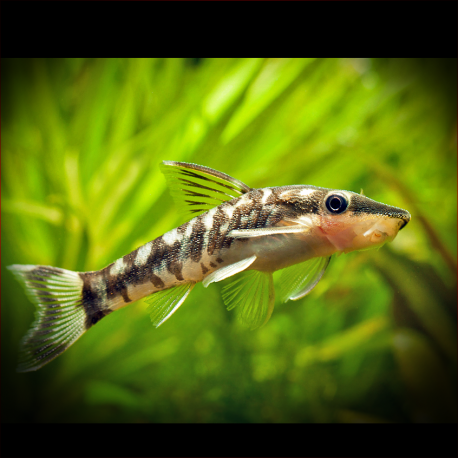More info
Datasheet
| Minimum Tank Size | 40 litres / 10.57 US gallons |
| Maximum Size | 4.5cm / 1.77inches |
| Temperature | 21°C / 69.80°F - 25°C / 77.00°F |
| Hardness | 2.02dgH / 36ppm - 10.03dgH / 179ppm |
| pH | 6.0-7.5 |
General Description
The Otocinclus Cocama, commonly known as Zebra O, is a miniature Loricariid fish introduced to the hobby in 2001 and scientifically described in 2004. Characterized by unique color patterns and complete lateral lines, it possesses a high number of teeth compared to other Otocinclus species. Belonging to the tribe Hypoptopomatini, it is thought to be monophyletic and widely distributed in South America. The genus Otocinclus was established by Cope in 1871 and has seen revisions and new species descriptions, with 18 valid species currently known.
Aquarium Setup
To keep an Otocinclus Cocama, a mature, densely-planted tank with floating vegetation, roots, twigs, and branches for structural complexity is essential. Adding dried leaf litter is beneficial as the fish graze on it during decomposition. Gentle filtration, like an air-powered sponge filter, is preferable, along with stable water conditions within a pH range of 6.0-7.5, hardness of 36-179ppm, and a temperature of 21-25°C. A minimum tank size of 40 litres is recommended.
Behaviour
Peaceful with other species but not suited for community tanks due to its small size and timid nature, Otocinclus Cocama thrives when kept alone or in groups of 6 or more. It grazes on algae from various surfaces and may display stress-related behaviors if the tank lacks vegetation, leading to health issues. The fish may exhibit unusual feeding habits if insufficient vegetable matter is available, emphasizing the need for a well-planted aquarium environment.
Feeding and Diet
Being vegetarian, Otocinclus Cocama feeds on algae and aufwuch in its natural habitat. In captivity, providing a good supply of algae, spirulina, kelp tablets, and blanched vegetables like spinach, cucumber, and zucchini is necessary. The fish must have access to a diet rich in vegetable matter to thrive. They may also feed from sinking foods once acclimated to the aquarium environment.
Reproduction & Dimorphism
Limited information is available on the reproduction of Otocinclus Cocama. It is presumed that the fry are tiny and require ample algae and green matter for survival. Sexual dimorphism is exhibited by males being slightly smaller than females, possessing a conical urogenital papilla and a flap on the dorsal surface of the unbranched pectoral fin, features absent in females.
Habitat and Distribution
Otocinclus Cocama is mostly found in small tributaries or slow-flowing marginal zones of larger rivers in South America. Typically associated with aquatic vegetation or terrestrial grasses growing in water, these fish congregate among vegetation in the upper water column. The species is distributed in the lower Ucayali and Marañón rivers in Peru, particularly in clear waters with dense marginal vegetation.

